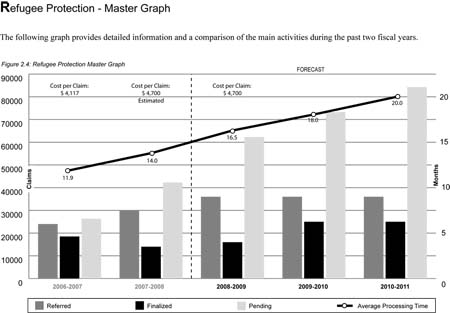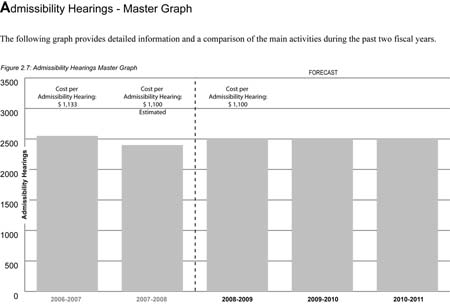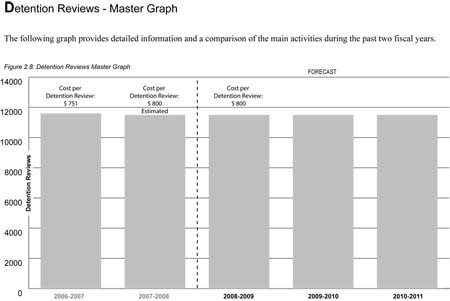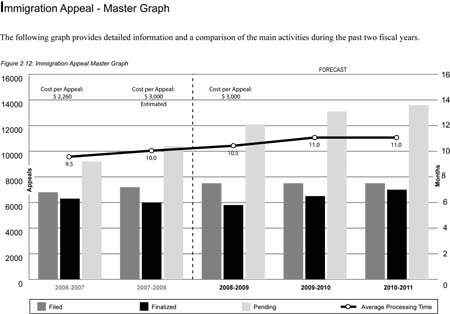Common menu bar links
Breadcrumb Trail
ARCHIVED - Immigration and Refugee Board of Canada
 This page has been archived.
This page has been archived.
Archived Content
Information identified as archived on the Web is for reference, research or recordkeeping purposes. It has not been altered or updated after the date of archiving. Web pages that are archived on the Web are not subject to the Government of Canada Web Standards. As per the Communications Policy of the Government of Canada, you can request alternate formats on the "Contact Us" page.
Section 2: Analysis of Program Activities by Strategic Outcome
This section provides detailed information on the plans and expected results and financial and human resources for the IRB's three program activities.
Common Elements
As noted in Section 1, the IRB prepares an IBP. The RPP and the Departmental Performance Report (DPR) are based on the plans and expected results presented in this annual plan.
A key part of the IRB's RPP, DPR and IBP is the identification of the plans and expected results of initiatives that are of common interest to the three program activities. The three program activities will work together to achieve these plans and expected results, which directly support the achievement of the IRB's 2008-2009 strategic priorities and strategic outcome.
Table 2.1: Common Elements in the IRB's Plans and Expected Results
| STRATEGIC OUTCOME: Resolve immigration and refugee cases before the Immigration and Refugee Board of Canada efficiently, fairly and in accordance with the law. | |
| STRATEGIC PRIORITY 1 Manage the case inventory through innovative adjudicative and case management strategies. |
|
| Plans | Expected Results |
| Integrated Case Management System (ICMS) | |
| Continued Implementation of ICMS | |
| ICMS Transition from the System for Tracking and Refugees (STAR) | |
| ICMS Maintenance: Identify and implement system enhancements through consultation and decision-making with the client (regions) |
|
| ICMS Caseload: Provide support to the regional operations to ensure processing of the RPD caseload in ICMS |
|
| ICMS Reporting: Review reporting mechanisms to support senior management decision-making and operational case management |
|
| ICMS | |
| ICMS Training | |
| Deliver system training/re-training to public service employees and decision-makers across the country via the ICMS training network, coaching/mentoring, e-learning modules, new decision-maker training, mock hearing room and/or classroom training |
|
| ICMS Modules | |
| Initiate consultations to map the business process and develop business requirements for the ID |
|
| Develop the National Reasons Database |
|
| Develop a framework for the use of videoconferencing and new technology across the divisions |
|
| Hearing readiness: take pre-hearing action to ensure that files are hearing-ready and to facilitate a proactive hearing |
|
| Evaluate the revised ID-IAD streamlining process and consider expansion to other regions |
|
| ID-IAD implementation of new legislation with respect to s. 86 in accordance with the law |
|
Deliver focused training on priority topics in order to:
|
|
| Liaise with Canada's administrative justice community and international partners in order to benefit from their experiences and best practices in the area of adjudicative and case management initiatives |
|
| STRATEGIC PRIORITY 2 Further integrate the work of the IRB to promote effective management. |
|
| Plans | Expected Results |
| Evaluate the IAD-RPD Western Region Integration pilot project and consider expansion to other regions |
|
| Develop a common approach to reducing adjournments/postponements across the divisions |
|
| STRATEGIC PRIORITY 3 Continue to build a flexible organization with clear accountabilities, ethical behaviour, leadership and operational capacity. |
|
| Plans | Expected Results |
| Implement an action plan further to the recommendations of the Roles and Responsibilities Review |
|
| Implement the revised IRB Code of Conduct for all decision-makers |
|
| Revise the complaint protocol and process for GIC decision-makers |
|
| Pursue recruitment efforts of GIC decision-makers for the RPD and the IAD |
|
| Put resource planning in place to ensure that the IRB has the necessary complement of decision-makers and the necessary support for new decision-makers throughout their integration |
|
| Review and update accountability profiles for GIC decision-makers and develop guidelines on the application of GIC terms and conditions of employment |
|
Distinct Program Activity Elements
The IRB's IBP also identifies the plans, expected results and operations that are distinct to each IRB program activity and contribute to achieving the IRB's strategic priorities for 2008-2009 and the IRB's strategic outcome. These are highlighted in the following detailed analyses; the detailed analysis for Internal Services is presented in Section 4.
Refugee Protection Program Activity
| The Refugee Protection program activity receives the majority of IRB resources and is focused on rendering quality and timely decisions on inland refugee protection claims. To deliver on this mandate, the Refugee Protection program activity depends on experienced decision-makers and adjudicative support. |
Total Planned Financial and Human Resources
Table 2.2: Refugee Protection Program Activity Total Planned Financial and Human Resources
| Financial Resources ($ millions) | ||
| 2008-2009 | 2009-2010 | 2010-2011 |
| 80.8 | 80.6 | 80.6 |
| Human Resources (FTEs) | ||
| 2008-2009 | 2009-2010 | 2010-2011 |
| 780 | 780 | 780 |
2008-2009 Outlook
The deficit of decision-makers in the Refugee Protection program activity continues. Throughout much of 2007-2008, the Refugee Protection program activity experienced an average shortfall of 36 percent in decision-makers. It is likely that a significant shortage will remain in 2008-2009 with 32 decision-makers reaching the end of their terms during the next fiscal year.
The growing deficit of decision-makers has a direct impact on the IRB's ability to render fast and fair decisions. Approximately six months of training and experience is required for a new decision-maker to become fully productive, i.e., to finalize refugee claim decisions.
Despite the number of challenges that the Refugee Protection program activity faces in the next fiscal year, it will continue to enhance its decision-making process. The Refugee Protection program activity remains committed to maintaining the high standard of decision-making that has earned its refugee determination process international recognition as one of the best in the world.
Key Plans and Expected Results
The Refugee Protection program activity will benefit from the expected results of the common elements identified in Table 2.1 to achieve its forecasts for 2008-2009. In addition to its contribution to the realization of the common elements, the Refugee Protection program activity will also undertake the plans and expected results outlined in the following table.
Table 2.4: Refugee Protection Program Activity Plans and Expected Results
| STRATEGIC OUTCOME: Resolve immigration and refugee cases before the Immigration and Refugee Board of Canada efficiently, fairly and in accordance with the law. | |
| STRATEGIC PRIORITY 1 Manage the case inventory through innovative adjudicative and case management strategies. |
|
| Plans | Expected Results |
| Implement a case management strategy to minimize the growing backlog of pending claims |
|
| Develop and implement an adjudicative strategy to ensure quality and efficiency of decision-making |
|
| Evaluate the RPD Language Analysis Pilot Project and present results to the Policy Advisory Committee |
|
| Develop the next steps for the Early Information Gathering (EIG) initiative |
|
| Improve the National Documentation Packages (NDPs) |
|
Outputs
The 2008-2009 outputs for the Refugee Protection program activity are as follows:
- Claims referred
- Claims finalized
- Claims pending
- Average processing time
- Average cost per claim finalized
Claims referred
Based on current trends, the Refugee Protection program activity expects that it will receive approximately 36,000 new claims in 2008-2009, 20 percent more than in 2007-2008.
Figure 2.1: Refugee Protection Claims Referred

(Click on image to enlarge)
Note: The numbers have been rounded off to the nearest hundred.
Claims finalized
Despite the significant shortage of decision-makers, the Refugee Protection program activity expects to finalize approximately 16,000 claims in 2008-2009, 14 percent more than in 2007-2008. This is due in part to continued enhancements in the decision-making process.
Figure 2.2: Refugee Protection Claims Finalized

(Click on image to enlarge)
Note: The numbers have been rounded off to the nearest hundred.
Claims pending
The significant decrease in decision-makers and unexpected influx of claims in 2007-2008 resulted in a pending inventory of approximately 42,300 claims; an amount that will increase in the next fiscal year without the required decision-makers. As a result, it is projected that the pending inventory could exceed 60,000 claims by the end of 2008-2009. Even with new appointments, this number will increase due in part to the time required to train new decision-makers.
Figure 2.3: Refugee Protection Claims Pending

Note: The numbers have been rounded off to the nearest hundred.
Average processing time
Based on the expectation that the Refugee Protection program activity will have a pending inventory of 62,300 claims in 2008-2009, the time required to finalize a claim will increase, and it may take on average 16.5 months to process a claim (from referral to finalization) in 2008-2009.
Average cost per claim finalized
Based on 16,000 claim finalizations, the average forecasted cost per claim is expected to be $4,700 for 2008-2009. The forecasted average cost per claim is higher than the 2006-2007 actual average cost of $4,117. The increase for 2008-2009 is attributable to several factors, including a higher share of fixed costs per unit caused by a decrease in the projected volume of claim finalizations and increased salary costs.
The cost per claim includes the decision-making costs and costs of related activities such as case preparation, research, scheduling of hearings, legal services, foreign-language interpretation, technological support, translation services and administrative support. It also includes a share of the costs from Internal Services, which is allocated to the three program activities, based on expenditure trends.

(Click on image to enlarge)
Admissibility Hearings and Detention Reviews Program Activity
| The Admissibility Hearings and Detention Reviews program activity holds hearings for foreign nationals or permanent residents who are alleged to be inadmissible to Canada pursuant to the provisions of the IRPA. Detention reviews are held concerning permanent residents and foreign nationals who are detained under the IRPA authority. Detainees must be seen by the Immigration Division within 48 hours and subsequent reviews must be conducted within specific timeframes as set out in the IRPA. Decision-makers must balance the rights of individuals to liberty with the security interests of Canadians and persons in Canada. |
Total Planned Financial and Human Resources
Table 2.5: Admissibility Hearings and Detention Reviews Program Activity Planned Financial and Human Resources
| Financial Resources ($ millions) | ||
| 2008-2009 | 2009-2010 | 2010-2011 |
| 15.2 | 15.2 | 15.2 |
| Human Resources (FTEs) | ||
| 2008-2009 | 2009-2010 | 2010-2011 |
| 105 | 105 | 105 |
2008-2009 Outlook
The number of admissibility hearings and detention reviews conducted by the IRB directly depends on the number of cases referred to it by the CBSA and CIC. In 2008-2009, the Admissibility Hearings and Detention Reviews program activity will continue to experience a moderate increase in referrals for admissibility hearings, while the number of detention reviews is expected to remain stable.
Key Plans and Expected Results
The Admissibility Hearings and Detention Reviews program activity will benefit significantly from the expected results of the common elements identified in Table 2.1 to achieve its forecasts for 2008-2009. In addition to its contribution to the realization of the common elements, the Admissibility Hearings and Detention Reviews program activity will undertake the plans and expected results outlined in the following table.
Table 2.7: Admissibility Hearings and Detention Reviews Program Activity Plans and Expected Results
| STRATEGIC OUTCOME: Resolve immigration and refugee cases before the Immigration and Refugee Board of Canada efficiently, fairly and in accordance with the law. | |
| STRATEGIC PRIORITY 1 Manage the case inventory through innovative adjudicative and case management strategies. |
|
| Plans | Expected Results |
Continue to implement a strategic approach to quality decision-making by:
|
|
Pursue cross-regional consistency efforts within the ID by:
|
|
Outputs
The 2008-2009 outputs for the Admissibility Hearings and Detention Reviews program activity are as follows:
- Admissibility hearings finalized
- Detention reviews finalized
- Average cost per admissibility hearing finalized
- Average cost per detention review finalized
Admissiblity Hearings finalized
The number of referrals for admissibility hearings has increased by 11 percent over the past three years. The Admissibility Hearings and Detention Reviews program activity expects to finalize 2,500 admissibility hearings in 2008-2009 and 2,500 admissibility hearings in each of the two following fiscal years.
Figure 2.5: Admissibility Hearings Finalized

(Click on image to enlarge)
Note: The numbers have been rounded off to the nearest hundred.
Detention Reviews finalized
The number of detention reviews remains stable. The Admissibility Hearings and Detention Reviews program activity anticipates that it will finalize approximately 11,500 detention reviews in 2008-2009 and in the two following fiscal years. Ongoing challenges include the pressures associated with meeting statutory timeframes, travelling to detention facilities to conduct reviews and increased public scrutiny in balancing the rights to liberty of individuals with the security of Canadians and persons in Canada. Criminality, an important factor in detention reviews, is an element that is present in a high proportion of cases, particularly those that involve long-term detention.
Figure 2.6: Detention Reviews Finalized

(Click on image to enlarge)
Note: The numbers have been rounded off to the nearest hundred.
Average cost per admissibility hearing and detention review finalized
Based on 2,500 admissibility hearings and 11,500 detention reviews, the average forecasted cost is expected to be $1,100 and $800 respectively for 2008-2009. These forecasted average costs are in line with the 2006-2007 actual average costs of $1,133 for admissibility hearings and $751 for detention reviews.
The cost per admissibility hearing and detention review includes decision-making costs and costs of related activities such as case preparation, research, scheduling of hearings, legal services, foreign-language interpretation, technological support, translation services and administrative support. It also includes a share of the costs from Internal Services, which is allocated to the three program activities, based on expenditure trends.
Figure 2.7: Admissibility Hearings Master Graph

(Click on image to enlarge)
Figure 2.8: Detention Review Master Graph

(Click on image to enlarge)
Immigration Appeal Program Activity
| The Immigration Appeal program activity hears immigration appeals from Canadian citizens and permanent residents whose applications to sponsor close family members to Canada have been refused. Other key functions include hearing appeals from permanent residents, foreign nationals with a permanent resident visa, protected persons who have been ordered removed from Canada and permanent residents outside of Canada who have not fulfilled their residency obligation. |
Total Planned Financial and Human Resources
Table 2.8: Immigration Appeal Program Activity Total Planned Financial and Human Resources
| Financial Resources ($ millions) | ||
| 2008-2009 | 2009-2010 | 2010-2011 |
| 17.4 | 17.4 | 17.4 |
| Human Resources (FTEs) | ||
| 2008-2009 | 2009-2010 | 2010-2011 |
| 140 | 140 | 140 |
2008-2009 Outlook
The shortfall in decision-makers in the Immigration Appeal program activity is expected to continue in 2008-2009. In 2007-2008, the Immigration Appeal program activity experienced an average shortfall of 31 percent in decision-makers.
Despite limited decision-maker resources in the past several years, the Immigration Appeal program activity continues to build successful procedural, adjudicative and administrative practices that increase its efficiency and productivity. However, new appointments and reappointments of decision-makers are essential for the Immigration Appeal program activity to be fully productive.
In 2008-2009, the Immigration Appeal program activity will have nine experienced decision-makers whose terms are expiring. Based on past experience, some reappointments and new appointments are anticipated. However, new decision-makers, who require training and experience, will not be fully productive until halfway into their first year. As a result, even with approximately the same level of decision-maker's, the full positive impact of new decision-makers will not be seen until later years.
Key Plans and Expected Results
The Immigration Appeal program activity will benefit from the expected results of the common elements identified in Table 2.1 to achieve its forecasts for 2008-2009. In addition to its contribution to the realization of the common elements, the Immigration Appeal program activity will undertake the plans and expected results outlined in the following table.
Table 2.10: Immigration Appeal Program Activity Plans and Expected Results
| STRATEGIC OUTCOME: Resolve immigration and refugee cases before the Immigration and Refugee Board of Canada efficiently, fairly and in accordance with the law. | |
| STRATEGIC PRIORITY 1 Manage the case inventory through innovative adjudicative and case management strategies. |
|
| Plans | Expected Results |
| Implement an inter-regional case inventory management plan, including continuation of the Central Region IAD backlog reduction plan |
|
Develop and implement adjudicative strategies to enhance consistency in decision-making. Areas may include:
|
|
| Increase the early resolution of appeals without a hearing: evaluate and improve EIR and ADR |
|
| Assess the effectiveness of initiatives and case streams implemented under IAD Innovation |
|
Outputs
The 2008-2009 outputs for the Immigration Appeal program activity are as follows:
- Appeals filed
- Appeals finalized
- Appeals pending
- Average processing time
- Average cost per appeal finalized
Appeals filed
The Immigration Appeal program activity anticipates 7,500 appeals will be filed in 2008-2009, which is a continuation of the moderate increases seen in the past few years. The increased intake is primarily a result of the increase in sponsorship appeals. The overall level of the intake is expected to continue to grow in 2008-2009 and 2009-2010 and remain high in subsequent years.
Figure 2.9: Immigration Appeals Filed

(Click on image to enlarge)
Note: The numbers have been rounded off to the nearest hundred.
Appeals finalized
The Immigration Appeal program activity expects to finalize approximately 5,800 appeals in 2008-2009; only three percent less than in 2007-2008. Despite the shortage of decision-makers, the Immigration Appeal program activity experienced only a small decrease in productivity due in part to continued enhancements in its innovative case processing. In later years, if the Immigration Appeal program activity can increase its decision-makers to a full complement, it will begin to reduce the large pending inventory and the average case processing times.
Figure 2.10: Immigration Appeals Finalized

(Click on image to enlarge)
Note: The numbers have been rounded off to the nearest hundred.
Appeals pending
The unexpected increase in appeals filed, together with the significant decrease in decision-makers in 2007-2008, particularly in the Western and Central Regions, resulted in a pending inventory of approximately 10,400 appeals at the end of the fiscal year. Without the required complement of decision-makers, this amount will increase in 2008-2009. As a result, it is projected that the pending inventory could exceed 12,000 appeals by the end of 2008-2009. Even with new appointments, the number may increase due in part to the time required to train new decision-makers.
Figure 2.11: Immigration Appeals Pending

(Click on image to enlarge)
Note: The numbers have been rounded off to the nearest hundred.
Average processing time
The average processing time is expected to increase to approximately 10.5 months in 2008-2009.
Average cost per appeal finalized
Based on 5,800 appeal finalizations, the forecasted average cost per appeal is expected to be $3,000 for 2008-2009. The average forecasted cost per appeal is higher than the 2006-2007 actual average cost of $2,260 per appeal. The increase for 2008-2009 is attributable to several factors, including a higher share of fixed costs per unit caused by a slight decrease in the projected volume of appeal finalizations, increased adjudicative support and increased salary costs.
The cost per appeal includes the decision-making costs and costs of related activities such as case preparation, research, scheduling of hearings, legal services, foreign-language interpretation, technological support, translation services and administrative support. It also includes a share of the costs from Internal Services, which is allocated to the three program activities, based on expenditure trends.
Figure 2.12: Immigration Appeal Master Graph

(Click on image to enlarge)
